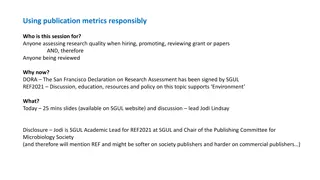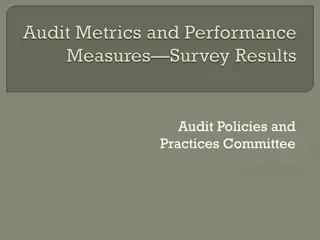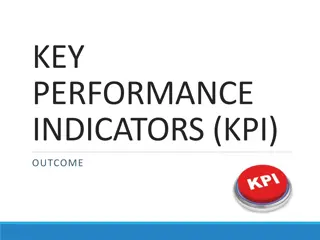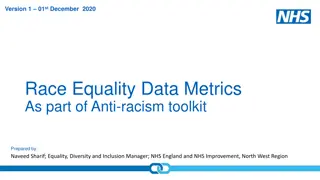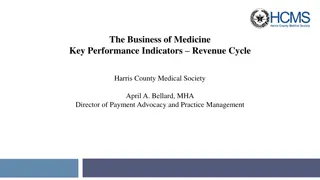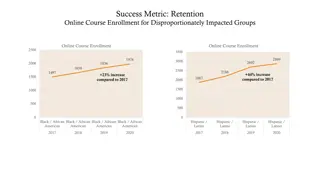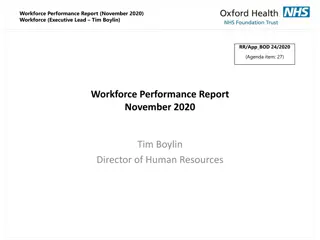
The Controversy Over KPI Metrics in Performance Management
Are KPI metrics the ultimate tools for performance management, or do they sometimes lead businesses astray? Our latest blog dives deep into the complexities of KPI metrics and dashboards, highlighting how their misuse and over-reliance can distort bu
Download Presentation

Please find below an Image/Link to download the presentation.
The content on the website is provided AS IS for your information and personal use only. It may not be sold, licensed, or shared on other websites without obtaining consent from the author. Download presentation by click this link. If you encounter any issues during the download, it is possible that the publisher has removed the file from their server.
E N D
Presentation Transcript
The Controversy Over KPI Metrics in Performance Management Let s talk about the Misuse and Misinterpretation of KPI Metrics With the landscape of performance management evolving at a fast pace,KPIs and dashboards serve as all too essential tools, providing real-time insights that guide strategic decision-making. Setting Key Performance Indicators (KPIs) is a common strategy for measuring and driving organizational performance. However, the practice of setting unrealistic KPI targets can lead to a host of problems, impacting not just individual and team morale but also the overall health of an organization.
Setting Unrealistic Targets Employee burnout is a serious possibility due to the enormous pressure that unrealistic KPIs put on them. The constant pressure to meet unreachable goals diminishes job satisfaction and can increase turnover rates. Employees may feel undervalued and overwhelmed, leading to a decline in productivity and mental health issues. This not only affects individual employees but can also ripple through the team, reducing overall morale and effectiveness. When companies consistently set unrealistic targets, it fosters a culture of short-termism and unethical behavior. Employees might resort to cutting corners to meet these targets, which can compromise the quality of work and the integrity of the business processes. This shift can erode trust within the organization and damage its reputation externally, making it harder to attract quality talent and retain customers. Pursuing unachievable goals often results in the inefficient use of resources. Teams may spend excessive time and budget on projects that, due to their scale, are unlikely to succeed within the set parameters. This misallocation can divert resources from more
viable projects that could offer better returns on investment, ultimately hindering the company's overall strategic objectives. Unrealistic targets can stifle innovation as employees focus on meeting immediate KPIs rather than pursuing creative solutions or long-term strategic initiatives. The pressure to deliver quick results discourages risk-taking and exploring new ideas, which are essential for innovation and sustainable growth. This can leave the company at a competitive disadvantage, especially in industries where innovation drives success. Root Causes of Unrealistic KPI Setting Misaligned Business Objectives- Unrealistic KPIs often stem from upper management s pressure to deliver exceptional results. This can be due to a misalignment between realistic operational capacities and executive expectations. Additionally, a lack of understanding of market conditions can lead businesses to set targets that are out of sync with economic realities or industry capabilities. Lack of Data-Driven Insights- Inadequate or incorrect data analysis can lead to setting targets that do not reflect historical performance or realistic growth trajectories. Projecting future performances without a solid statistical basis results in overly optimistic KPI targets. Enhancing data analytics capabilities and involving data experts in the KPI setting process can mitigate these issues. Over-Reliance on KPIs and Its Strategic Implications In the landscape of business intelligence and performance management, KPIs and dashboards are indispensable tools. However, an over-reliance on these metrics, especially without considering their limitations, can lead to strategic missteps and operational inefficiencies. Let s see why it s a bad idea to fall more dependent than necessary on KPI metrics: Narrow Focus and Tunnel Vision- When businesses overly depend on KPI metrics, there's a risk of developing tunnel vision, where the focus on specific numbers overshadows other qualitative or intangible factors critical to business success. For example, a company might concentrate solely on "KPI metric UK sales volumes" without
considering customer satisfaction or brand reputation, which are not as easily quantified but are vital for long-term success. False Sense of Security- Performance may be quickly and easily assessed with the use of KPI dashboard systems. Over-reliance on these snapshots can create a false sense of security. Managers might assume that if the primary KPIs are being met, all aspects of the business are performing well, potentially overlooking underlying issues that are not captured by the current KPI metrics. This scenario is particularly common when KPIs are not regularly updated to reflect the ever-changing business landscape. Innovation Stifling- An excessive focus on meeting specific KPI metrics can stifle innovation within an organization. Employees and managers might be less likely to pursue novel ideas or creative solutions that do not directly contribute to the immediate KPIs being tracked. This behavior can prevent a company from adapting to new market demands or exploring growth opportunities outside the scope of their existing KPI framework. Several businesses have learned hard lessons by focusing too narrowly on KPIs. For instance, a tech company might track the number of new software features deployed as a KPI metric. While initially beneficial, this focus can lead to the release of features that add little value to the user experience, diluting product quality and customer satisfaction in pursuit of hitting a numerical target. Research has shown that companies that balance quantitative KPIs with qualitative insights tend to perform better in the long run. Incorporating qualitative data, such as employee feedback and customer satisfaction scores, helps provide a more comprehensive view of the company s health beyond what is immediately measurable. Lack of Context in KPI Metrics Without proper context, KPI metrics can be misinterpreted, leading to decisions that may not align with the actual health or needs of the business. For instance, a spike in customer service calls might initially seem like a sign of increasing customer dissatisfaction. However, if the context reveals that the spike coincides with a new product launch, this KPI could actually indicate heightened interest and engagement rather than a problem.
KPIs devoid of context can cause misalignments with broader business strategies. For example, if a company focuses solely on cutting costs as a KPI without understanding the context of necessary quality maintenance, it may inadvertently reduce the quality of its products or services, harming its brand reputation and customer satisfaction in the long term. Operating based on KPIs that lack context can lead to inefficient operational adjustments. Departments might shift their workflows or resource allocations based on KPIs that do not account for seasonal variations, market trends, or other external factors, leading to disruptions that could have been averted if a more sophisticated strategy had been employed. Root Causes of the Lack of Context in KPI Setting Insufficient Data Integration- Often, KPIs are set using data that is isolated from other relevant business data streams. This siloed approach fails to incorporate a holistic view of the business environment, leading to KPIs that do not account for the interdependencies between different areas of the business. Over-reliance on Quantitative Metrics- A common pitfall is the overemphasis on quantitative data at the expense of qualitative insights. Businesses might track numbers meticulously while neglecting the stories behind those numbers stories that could provide crucial context for understanding what the metrics really mean. Inadequate Stakeholder Involvement- The lack of context can also stem from not involving a diverse range of stakeholders in the KPI setting process. Different perspectives, particularly from frontline employees who understand the day-to-day operations, are essential in framing KPIs within the appropriate business contexts. Considerations: Industry Variations: Different industries require different KPIs. For example, in manufacturing, operational efficiency KPIs are crucial, while in tech, innovation, and customer engagement metrics might take precedence.
Company Size and Stage: Startups might focus on growth and market penetration KPIs, whereas established companies sustainability metrics. Geographic Factors: KPI metrics in the UK might differ from those in other regions due to varying market conditions, regulatory environments, and consumer behavior. Tailoring KPIs to geographic specifics is essential for accuracy and relevance. might prioritize profitability and How do we curb these pitfalls and controversies? Strategies for Setting More Realistic KPIs Enhanced Data Analysis- Utilizing sophisticated data analytics tools, such as those provided by BI platforms like Grow, can help in setting more accurate KPIs by analyzing historical data and market trends. Continuously updating and reviewing data inputs ensures that KPIs reflect the current business environment and are aligned with achievable outcomes. Involving Broader Team Inputs- Engaging employees in the KPI setting process ensures that targets are based on ground-level insights and are more realistic and achievable. Establishing channels for ongoing feedback can help organizations adjust KPIs in real-time, aligning them more closely with what is practical and motivating. Setting SMART KPIs- KPIs should be Specific, Measurable, Achievable, Relevant, and Time-bound. They should be clearly defined, with a reliable method to measure progress, set within a reasonable timeline, and aligned with broader business goals and strategies. Strategies for Incorporating Context in KPI Analysis Integrating Qualitative Data- One effective strategy to enhance the contextuality of KPIs is integrating qualitative data with quantitative metrics. For instance, augmenting sales volume data (a quantitative KPI) with customer satisfaction surveys (a qualitative measure) can provide a more holistic view of a company s performance. Utilizing Advanced BI Tools- Advanced Business Intelligence (BI) tools like Grow s KPI dashboard facilitate a deeper analysis by allowing businesses to layer multiple data
sources, thus providing a richer, more comprehensive context. For example, correlating sales data with marketing campaign timelines, external economic indicators, and demographic data can help businesses understand the true drivers behind their sales performance. Regular Context Reviews- Regularly reviewing the contextual basis for KPI metrics is essential, especially for dynamic markets like the UK. This involves updating the KPI framework to reflect any changes in the business environment, economic conditions, or company strategy. SMART KPI solutions those that are Specific, Measurable, Achievable, Relevant, and Time-bound should be revisited to ensure they still align with the business s current context. Strategies for Mitigating Over-Reliance on KPIs Balanced Scorecard Approach- One effective strategy is the balanced scorecard approach, which involves measuring KPIs across four key business perspectives: financial, customer, internal processes, and learning and growth. This method ensures that the focus on financial KPIs is complemented by other important areas, providing a more holistic view of organizational performance. Integration of BI Tools- Advanced Business Intelligence tools like Grow s KPI dashboard can be configured to provide a more nuanced view of performance metrics. By setting up dashboards that integrate both high-level KPIs and deeper, underlying data streams, businesses can monitor their performance more comprehensively. For instance, alongside tracking sales figures (a common KPI metric), a dashboard could also display related customer engagement metrics and operational efficiency indicators. Regular Review and Adaptation of KPIs- To ensure KPIs remain relevant and aligned with business objectives, it s crucial to regularly review and update them. This adaptation should be informed by ongoing business developments, market changes, and stakeholder feedback. Employing SMART KPI systems specific, measurable, achievable, relevant, and time-bound is critical in this continuous improvement process. Conclusion The debate surrounding KPI metrics in performance management is a testament to their complexity and power. KPIs are more than mere numbers; they are reflections of
strategy, culture, and market realities. While they are essential for driving performance, their true value is unlocked only when used with a deep understanding of context and a balanced approach. Missteps like over-reliance and lack of contextual awareness can turn these tools into double-edged swords, potentially derailing business objectives. Enter Grow, where KPI metrics are transformed from static figures into dynamic insights. Our advanced BI platform doesn't just display numbers; it tells the story behind them. With Grow s customizable KPI dashboards, you gain a panoramic view of your business, integrating multiple data sources for a narrative that's as comprehensive as it is actionable. We believe that true performance management isn't about chasing numbers it's about understanding them. For those ready to transcend traditional KPI management, Grow offers an unparalleled opportunity. Start with our 14-day free trial and witness how our platform can redefine your approach to KPIs. Experience firsthand the depth of insight and ease of use that has garnered us top ratings on "Grow.com Reviews & Ratings 2024 TrustRadius." Our users don't just manage performance; they master it. Seize the future of performance management today. Visit Grow.com and embark on a journey from metrics to mastery. This is more than a trial; it s your gateway to a smarter, more intuitive way of doing business. Original Source: https://bit.ly/4frVIfS



